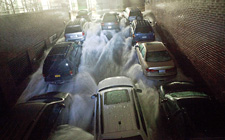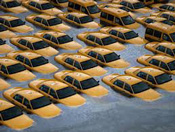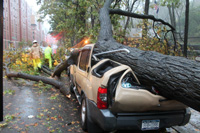redo Jump to...
print Print...

Rising water, caused by Hurricane Sandy, rushes into a underground parking garage in New York City on October 29, 2012.
(by Neal Boudette and Matthew Dolan, The Wall Street Journal) – …Hurricane Sandy is taking a heavy toll on cars and trucks throughout the [northeast] region – either swamping them in floodwaters or inflicting damage through fallen branches or downed trees.
No estimates are available on the number of vehicles that might be damaged but media reports are showing plenty of submerged and wrecked cars from Cape May, N.J., to lower Manhattan to Long Island, N.Y.
Hurricanes typically bring a boomlet in auto sales to regions that are affected, said Pete DeLongchamps, vice president for manufacturer relations at Group 1 Automotive Inc., a large dealership chain that owns four stores on Long Island and six in New Jersey, including three near the hard-hit resort of Atlantic City.

Even the taxi fleet took a hit from hurricane Sandy. These cabs were swamped in a Hoboken, New Jersey lot.
“We usually see it over about the next 60 days,” he said by phone from the company’s headquarters in Houston. “People need to get to work, so they go out pretty quickly to get a new car.”
Years ago, the industry had a rule of thumb about cars caught in floods – if the water rose to the level of the ashtray, the car was totaled, unfixable. But these days it doesn’t always take waist-deep water to turn cars into junk – mainly because today’s vehicles are jammed with sensitive electronics that are expensive to replace.
Even if they are repaired, owners of waterlogged vehicles may be forced to scrap them. Vehicle damage reports are widely available on the Internet and [help in spotting] cars that have suffered heavy flood damage, said Ricky Beggs, vice president and managing editor of Black Book, a guide to the wholesale market for used car dealers. [In addition, sound advice, which applies to any used-car purchase, is to have a trusted mechanic check it out before purchasing the vehicle.]
The damage to cars from floods can be extensive depending on the water level, length of time in the water and type of water including contaminants, consumer advocates say. More than 600,000 vehicles had some level of water damage after Hurricane Katrina struck the Gulf region in 2005. Many of those vehicles were resold, sometime to unsuspecting customers in far away states who weren’t aware of the damage.
Due to the wide swath of the storm damage up and down the East Coast, “the impact could be bigger than Katrina,” Mr. Beggs said. There is a strong possibility that newer models will need to be replaced because the Northeast has a higher concentration of leased vehicles which are only a few years old, he said. That could boost both the new and used car markets, according to Mr. Beggs.
Sandy has posed danger for auto dealers as well as owners. Dealerships tend to be located on high ground, away from flood zones, but their inventories of cars can be exposed to downed power lines, or wind or hail damage. Even if cars suffer minor damage, they sometimes can no longer be sold as new, lowering their value to dealers.
From its Houston headquarters, Group 1 prepares for the hurricane season every summer. Company executives began holding conference calls last week with store managers in Sandy’s path, said Brooks O’Hara, vice president of human resources. The managers were advised to make sure their underground gasoline tanks were filled, in case the storm slowed fuel deliveries. Any vehicles in for repairs were to be fixed and returned to owners, leaving room in dealership garages for as many new cars as they could jam in, he said.
“We learned a lot from Katrina and we go through this all the time, being down in the Gulf,” Mr. O’Hara said.
Write to Neal E. Boudette at neal.boudette@wsj.com and Matthew Dolan at matthew.dolan@wsj.com.
Copyright 2012 Dow Jones & Company, Inc. All Rights Reserved. Reprinted here for educational purposes only. Visit the website at wsj.com.
Questions
2. How do auto dealers benefit from hurricanes?
3. a) Define “rule of thumb.”
b) Why has the rule of thumb changed for totaling cars caught in floods?
4. How can consumers protect themselves from unknowingly buying a car that has been flooded?
5. What factors contribute to the type of damage a car sustains from flooding?
6. a) How can auto dealers be negatively impacted by hurricanes?
b) What preparations do they make to avoid potential damage due to hurricanes?
Background
How to avoid buying a car that was flooded:
Sound advice, which applies to any used-car purchase, is to have a trusted mechanic check it out.
That’s regardless of obtaining any accompanying paperwork, up to and including a vehicle history report. Still, it’s also worth asking to see the paperwork. By rights, cars that have been reported flooded and totaled by an insurance company should have that fact noted on the car’s title. That is, if the owner submitted an insurance claim.
So the paperwork will disclose flood damage if the seller is honest. That’s not always the case.
According to the insurance industry’s National Insurance Crime Bureau (NCIB), Hurricane Floyd in 1999 damaged 75,000 vehicles. More than half were put back out on the road. In 2005, Hurricane Katrina, Hurricane Rita and Hurricane Wilma claimed more than 600,000 cars. They are still showing up for sale around the country, the NICB said.
The list goes on and on, soon to be joined by Hurricane Sandy. It’s not illegal to sell a car that’s been flooded. What’s illegal is selling a car that’s had significant flood damage without disclosing the damage.
Besides NICB, other sources of advice for detecting flood-damaged cars include the National Association of Attorneys General, Edmunds.com and many more.
(from Forbes.com)
AAA released a list of tips for dealing with vehicles that may have been flooded. For car shoppers, particularly those in the used-car market, there is advice on how to spot a car that may have suffered flood damage.
“In addition to the obvious damage done to upholstery and carpeting, flood water is a corrosive and abrasive mixture of water and dirt that works its way into every seam and crevice of a vehicle,” said AAA spokesman John Nielsen.
“Most vulnerable are the engine, transmission and drive train, along with the fuel, brake and power steering systems. Unless dirt and other contaminants are completely removed from these important vehicle components, increased wear and premature failure can result,” Nielsen said. Engine computers, sensors and other electronics are susceptible to corrosion.
Most important: Do not try to start a flood-damaged car until a qualified mechanic has done the following:
- Inspect mechanical and electrical components, and systems that contain fluids, for water contamination.
- Drain flood water from contaminated parts and systems, flush with clean water or an appropriate solvent, and refill with fresh fluids.
- Inspect, clean, and dry electrical system components and connections.
Depending on the vehicle make, model and age, the cost of such an effort may exceed the car’s value. AAA encourages motorists to contact their insurance companies first for help in determining the best course of action when dealing with a flood-damaged vehicle.
To avoid buying a flood-damaged vehicle, arrange a pre-purchase inspection at a qualified shop. Inspectors will look for tell-tale signs of flood damage like dried mud under the hood or inside the trunk. A damp or musty odor in the vehicle is often a sign of trouble. New carpeting and upholstery in older vehicles may also be hiding serious problems.
A vehicle history report can also be helpful. While they may not catch every potential problem the usually indicate when a car has been flooded or has a salvage title, which is a sign of a troubled past. (from wsj.com)
Daily “Answers” emails are provided for Daily News Articles, Tuesday’s World Events and Friday’s News Quiz.




